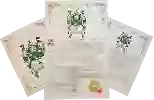
Winery Paul Jaboulet AînéParalléle 45 Côtes du Rhône Rouge
This wine is a blend of 5 varietals which are the Marsanne, the Mourvèdre, the Roussanne, the Syrah and the Grenache noir.
In the mouth this red wine is a powerful with a nice balance between acidity and tannins.
This wine generally goes well with beef, game (deer, venison) or lamb.
Taste structure of the Paralléle 45 Côtes du Rhône Rouge from the Winery Paul Jaboulet Aîné
Light | Bold | |
Smooth | Tannic | |
Dry | Sweet | |
Soft | Acidic |
In the mouth the Paralléle 45 Côtes du Rhône Rouge of Winery Paul Jaboulet Aîné in the region of Rhone Valley is a powerful with a nice balance between acidity and tannins.
Wine flavors and olphactive analysis
On the nose the Paralléle 45 Côtes du Rhône Rouge of Winery Paul Jaboulet Aîné in the region of Rhone Valley often reveals types of flavors of iron, pineapple or cream and sometimes also flavors of cherry, grapefruit or tropical.
Food and wine pairings with Paralléle 45 Côtes du Rhône Rouge
Pairings that work perfectly with Paralléle 45 Côtes du Rhône Rouge
Original food and wine pairings with Paralléle 45 Côtes du Rhône Rouge
The Paralléle 45 Côtes du Rhône Rouge of Winery Paul Jaboulet Aîné matches generally quite well with dishes of beef, lamb or game (deer, venison) such as recipes of oxtail with seed sauce, lamb stew from my mum or rabbit with beer.
Details and technical informations about Winery Paul Jaboulet Aîné's Paralléle 45 Côtes du Rhône Rouge.
Discover the grape variety: Marsanne
Marsanne is a white grape variety that originated in Montélimar in the Drôme, several centuries ago. Marsanne is also found in Cassis, Savoie, Languedoc-Roussillon and Saint-Péray in the Ardèche, where it produces remarkable sparkling wines. The warm, sunny climate of the Rhone Valley, Languedoc-Roussillon and Provence, as well as the dry, stony soil, are ideal conditions for its development. Its bunches are quite large and provide small, juicy berries that are sensitive to grey rot and strong winds. These two grape varieties complement each other perfectly: together they give light wines with little acidity, aromas of yellow fruit, white fruit and flowers with notes of honey and liquorice. This is for example what the appellations Saint-Péray, Hermitage, Crozes-Hermitage, Saint-Joseph, Côtes-du-Vallée du Rhône, Corbières, or Cassis express... which represent about 700 hectares.
Last vintages of this wine
The best vintages of Paralléle 45 Côtes du Rhône Rouge from Winery Paul Jaboulet Aîné are 2023, 2022, 2020, 2018 and 2017.
Informations about the Winery Paul Jaboulet Aîné
The Winery Paul Jaboulet Aîné is one of of the world's great estates. It offers 80 wines for sale in the of Côtes-du-Rhône to come and discover on site or to buy online.
The wine region of Côtes-du-Rhône
The wine region of Côtes-du-Rhône is located in the region of Rhône méridional of Rhone Valley of France. Wineries and vineyards like the Château de Beaucastel or the Chateau de Fonsalette produce mainly wines red, white and pink. The most planted grape varieties in the region of Côtes-du-Rhône are Mourvèdre, Viognier and Marsanne, they are then used in wines in blends or as a single variety. On the nose of Côtes-du-Rhône often reveals types of flavors of pineapple, red plum or sour cherry and sometimes also flavors of truffle, juniper or clove.
The wine region of Rhone Valley
The Rhone Valley is a key wine-producing region in Southeastern France. It follows the North-south course of the Rhône for nearly 240 km, from Lyon to the Rhône delta (Bouches-du-Rhône), near the Mediterranean coast. The Length of the valley means that Rhône wines are the product of a wide variety of soil types and mesoclimates. The viticultural areas of the region cover such a distance that there is a widely accepted division between its northern and southern parts.
The word of the wine: Presses
The juice that results from pressing the grapes after fermentation. At the end of the maceration, the vats are emptied, the first juice obtained is called the free-run wine and the marc remaining at the bottom of the vat is then pressed to give the press wine. We say more quickly "the presses". Their quality varies according to the vintage and the maceration. A too vigorous extraction releases the tannins of pips and the wine of press can then prove to be very astringent. Often the winemaker raises it separately, deciding later whether or not to incorporate it totally or partially into the grand vin.














